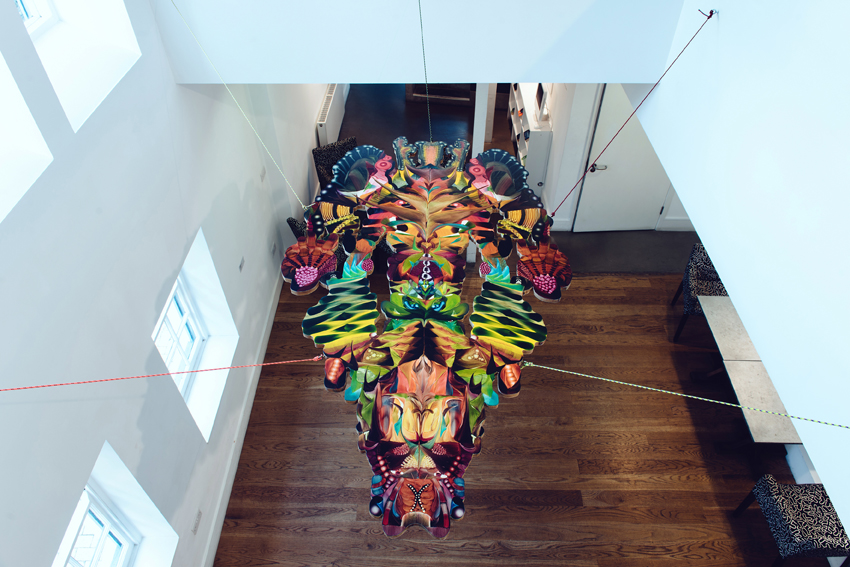‘The First Humans’
Plymouth Arts Centre, 15th January – 2nd April 2016.
‘The First Humans’ explores themes of pre-history, evolution and sci-fi imaginings of early man. Curated by Angela Kingston and organised by The Pump House Gallery in collaboration with Plymouth Arts Centre, ‘The First Humans’ features the work of Caroline Achaintre, Salvatore Arancio, Vidya Gastaldon, Andy Harper, Ben Rivers and Jack Strange.

‘That Thing Outside of The Thing Inside of This Thing’, Jack Strange (Photo: Dom Moore)
Upon entering the lower gallery space, you are confronted by a large boulder, entitled That Thing Outside of The Thing Inside of This Thing, by Jack Strange. A man-made boulder inset with three videos of the artist juggling, as an ape, a caveman and an alien. Vidya Gastaldon’s surreal illustrations of possible ancestors sit on the walls, almost like parts of an ancient frieze. Salvatore Arancio’s work, a ceramic geode formation, seemingly oozing with primordial Marmite, hangs high on the wall, sitting next to a highly detailed etching of a volcano.
Moving upstairs, Arancio’s etchings of volcanoes become more poignant upon watching Ben Rivers’ film The Creation as We Saw It, which candidly depicts a creation story from a tribal village in the South Pacific. Shot on 16mm film, in black and white, it gives the impression of an educational film from the early 20th century, an impression which is broken when you see the villagers using mobile phones. This beautiful piece of cinema puts the rest of the work into context.

Still from ‘The Creation as We Saw it’, Ben Rivers (Photo: Dom Moore)
Caroline Achaintre’s Fevver is a collection of tufted wall hangings that make the space cave-like, even more so placed next to more of Arancio’s ceramic rock formations. Loosely woven, they are obviously hand made, and elicit images of tribal altars or ceremonial garments. Kingston notes ‘(Fevver) has the look of something ceremonial’. Arancio’s ceramics are akin to stalactites, fossilized waste or small wells, filled with dark pools of oil.


Installation views, Caroline Achaintre, Fevver and Salvatore Arancio, Island/Black Sun (Photos: Dom Moore.)
Andy Harper’s work The Threefold Law, a two-dimensional piece suspended over the mezzanine level of the Art Centre’s space, is highly coloured, highly patterned and quite psychedelic. Something between a magic eye and a Rorschach test, it gives of the impression of having ritualistic significance: a mask of sorts. Harper’s other works, a triptych of similarly swirling and psychedelic patterns, are more delicate.

The Threefold Law, Andy Harper (Photo: Dom Moore.)
A genuine locally found paleolithic hand axe is amongst these works, kindly lent by Plymouth City Museum & Art Gallery. The hand axe sits in front of Strange’s What Do You Want More Of?, a wall of cardboard, punctuated with pairs of semi-precious gemstones, could these be representations of figures with ‘eyes’ of stone, or a formation – a dwelling or vehicle with ‘buttons’? The gemstones seem to have a magical importance, paired with the banal cardboard.


What Do You Want More Of?, Jack Strange; paleolithic hand axe found near Dartmoor (Photos: Dom Moore)
Carefully curated, and making good use of Plymouth Art Centre’s space, the exhibition feels like a legitimate museum display. ‘The First Humans’ playfully explores ideas of creation, evolution, human ritual, and just what it is to be human.
Emily Watkins, Plymouth College of Art.
http://www.plymouthartscentre.org/art/live/2015/the-first-humans.html

One thought on “‘The First Humans’, Plymouth Arts Centre”
Comments are closed.